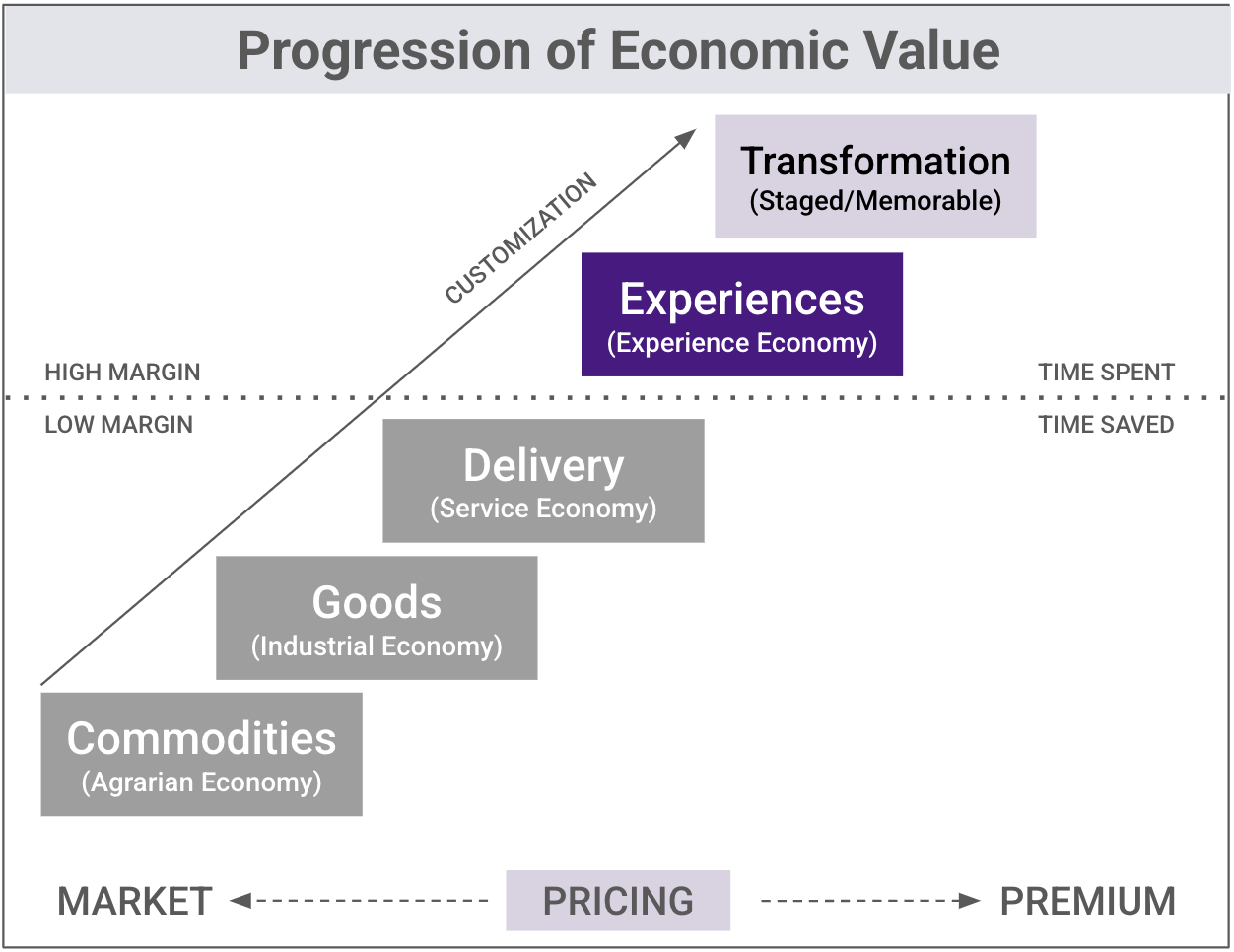Understanding these five levels of economic value—commodity, Goods, Deliver, Experience, and Transformation—can help hoteliers identify their current status and how they can evolve their offerings within each level. Each level unlocks new opportunities to enhance guest satisfaction, improve revenue, and remain competitive.
Overview of the model
The progression of the economy model applies to any industry where the first step provides basic commodities, and the last step delivers transformational experiences. Each level requires different offerings, target audiences, and pricing strategies to maximize revenue and guest satisfaction. Let’s look at each step and how it is applied to the hotel industry.

Commodity: Just a Bed to Stay Overnight
Description: Hotels at the commodity level focus on providing the most basic form of accommodation—a clean bed and a safe place to sleep. There are no frills, no added services, and minimal personalization.
Examples: Budget hotels, hostels, and capsule hotels.
Characteristics:
- Minimal amenities (e.g., a bed, shower, basic toiletries).
- High focus on price competitiveness.
- These hotels offer little to no additional services or experiences.
- Typically located in central areas or near transportation hubs to attract budget travelers.
Target Audience: Price-conscious people, backpackers, and business travelers with limited budgets.
Rate: Low. Pricing is highly competitive and often the main differentiator.
Marketing Mix (4Ps):
- Product: Basic room, clean bed, essential amenities.
- Place: Central locations or near transportation hubs.
- Promotion: Focus on price promotions and OTA listings.
- Price: Competitive pricing to attract budget travelers.
Goods: Including Breakfast
Description: Hotels at this level offer some additional goods or services included in the price, such as breakfast or a welcome drink. This step adds more value to the basic stay.
Examples: Mid-range hotels, B&Bs.
Characteristics:
- Basic room with added services such as breakfast.
- Simple personalization, such as a welcome kit.
- Suitable for travelers seeking more comfort than just a place to sleep.
Target Audience: Leisure travelers looking for convenience and a bit more comfort.
Rate: Slightly higher than commodity hotels but still relatively affordable.
Marketing Mix (4Ps):
- Product: Room plus breakfast, simple additional services.
- Place: Convenient locations for leisure travelers.
- Promotion: Package deals, including services like breakfast.
- Price: Value-based pricing for added services.
Deliver: Additional Service Offerings
Description: These hotels enhance the guest experience with curated services beyond basic accommodation. They may offer wellness facilities, concierge services, or activity packages.
Examples: Boutique hotels and full-service hotels.
Characteristics:
- Personalized services such as concierge or wellness packages.
- F&B options beyond breakfast (e.g., restaurant dining).
- Curated experiences, such as local tours or activities.
Target Audience: Guests seeking convenience, relaxation, and curated experiences.
Rate: Mid to high, reflecting the additional services offered.
Marketing Mix (4Ps):
- Product: Curated services such as concierge, wellness packages, and F&B options.
- Place: Prime locations with attractive surroundings.
- Promotion: Highlight curated services and local experiences.
- Price: Premium pricing reflecting curated services.
Experience: Superior Products, Services, and Personalization
Description: At this level, the hotel becomes a destination itself. It offers unique and memorable experiences beyond the stay, with superior products, services, and personalization.
Examples: Luxury resorts, themed hotels, adventure lodges.
Characteristics:
- Immersive experiences such as cooking classes or cultural tours.
- Superior service and amenities.
- High level of personalization for guests.
Target Audience: Guests looking for unique, unforgettable experiences.
Rate: Premium. Guests are willing to pay for high-value experiences.
Marketing Mix (4Ps):
- Product: Unique and personalized experiences and premium amenities.
- Place: Destinations themselves, offering immersive experiences.
- Promotion: Storytelling marketing focusing on unique experiences.
- Price: High-end pricing for unique, unforgettable experiences.
Transformation: The Guest is Transformed
Description: Hotels at this level focus on providing transformational experiences that impact the guest’s life. These hotels go beyond experiences to change how guests feel or think.
Examples: Wellness retreats, medical hotels, digital detox resorts.
Characteristics:
- Hotels aim to offer programs such as fitness camps or mental wellness retreats for personal growth.
- Exclusive and remote locations.
- Highly personalized programs tailored to individual needs.
Target Audience: Guests seeking self-improvement and long-term change.
Rate: High to very high. Guests are willing to invest significantly in transformational experiences.
Marketing Mix (4Ps):
- Product: Transformational programs like retreats, wellness, and self-improvement.
- Place: Exclusive, remote locations ideal for retreats.
- Promotion: Emphasize personal transformation and testimonials.
- Price: Luxury pricing reflects the transformational value.
Conclusion and Takeaways
The economic progression model provides a powerful framework for hotels to understand their market position and how they can evolve their offerings. However, moving between the progression steps is a significant challenge, if at all possible. Hotels tailor their physical infrastructure, design, and service model to a specific stage. Changing these aspects requires substantial investment and a complete repositioning in the market.
Most hotels’ best strategy is maximizing revenue and profit within their current step. By focusing on optimizing their existing offerings and leveraging opportunities within their category, hotels can achieve sustainable success. Attempting to move up to the next level without a complete refurbishment and rebranding can lead to becoming the least demanded option in the higher category, ultimately harming the business.
The key takeaway is that hotels should aim to be the best in their respective step. Understanding the needs of their target audience and delivering exceptional value within their category will ensure long-term profitability and guest satisfaction. Each level offers unique opportunities, and hotels should capitalize on these rather than trying to be something they are not.






